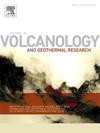Experimental verification for self-organization process on the spatial distribution and edifice size of rootless cone
IF 2.4
3区 地球科学
Q2 GEOSCIENCES, MULTIDISCIPLINARY
Journal of Volcanology and Geothermal Research
Pub Date : 2025-02-01
DOI:10.1016/j.jvolgeores.2024.108221
引用次数: 0
Abstract
We discuss the decision factor of the spatial distribution of rootless eruption, continuous explosions caused by interactions between lava and water. Signs of these eruptions are found on both Earth and Mars, and their spatial distribution is believed to be self-organized due to the scramble for available volatile substances, such as water. An analog experiment of rootless eruptions was conducted to verify this self-organization process using syrup and baking soda. This study focused on “failed conduits” disturbed by surrounding conduits and could not form stable paths to the surface. Through the experiments, we found that the self-organization process is driven by the competition for both available volatile substances and conduits. Candidates of such failed conduits could be found in nature where high-temperature lava and shallow groundwater were met. The role of the conduit-merge effect is deemed important in determining the spatial distribution pattern and edifice size of rootless cones on Earth and other planetary bodies.
无根锥体的空间分布和结构尺寸自组织过程的实验验证
我们讨论了无根喷发空间分布的决定因素,无根喷发是由熔岩和水相互作用引起的连续爆炸。这些喷发的迹象在地球和火星上都有发现,它们的空间分布被认为是自组织的,原因是对水等可用挥发性物质的争夺。为了验证这种自组织过程,我们使用糖浆和小苏打进行了一次无根喷发的模拟实验。这项研究的重点是受周围导管干扰、无法形成通往地表的稳定路径的 "失败导管"。通过实验,我们发现自组织过程是由对可用挥发性物质和导管的竞争驱动的。在高温熔岩和浅层地下水相遇的自然界中,可以找到这种失败导管的候选者。导管-合并效应的作用被认为在决定地球和其他行星体上无根锥的空间分布模式和建筑物规模方面具有重要意义。
本文章由计算机程序翻译,如有差异,请以英文原文为准。
求助全文
约1分钟内获得全文
求助全文
来源期刊
CiteScore
5.90
自引率
13.80%
发文量
183
审稿时长
19.7 weeks
期刊介绍:
An international research journal with focus on volcanic and geothermal processes and their impact on the environment and society.
Submission of papers covering the following aspects of volcanology and geothermal research are encouraged:
(1) Geological aspects of volcanic systems: volcano stratigraphy, structure and tectonic influence; eruptive history; evolution of volcanic landforms; eruption style and progress; dispersal patterns of lava and ash; analysis of real-time eruption observations.
(2) Geochemical and petrological aspects of volcanic rocks: magma genesis and evolution; crystallization; volatile compositions, solubility, and degassing; volcanic petrography and textural analysis.
(3) Hydrology, geochemistry and measurement of volcanic and hydrothermal fluids: volcanic gas emissions; fumaroles and springs; crater lakes; hydrothermal mineralization.
(4) Geophysical aspects of volcanic systems: physical properties of volcanic rocks and magmas; heat flow studies; volcano seismology, geodesy and remote sensing.
(5) Computational modeling and experimental simulation of magmatic and hydrothermal processes: eruption dynamics; magma transport and storage; plume dynamics and ash dispersal; lava flow dynamics; hydrothermal fluid flow; thermodynamics of aqueous fluids and melts.
(6) Volcano hazard and risk research: hazard zonation methodology, development of forecasting tools; assessment techniques for vulnerability and impact.

 求助内容:
求助内容: 应助结果提醒方式:
应助结果提醒方式:


